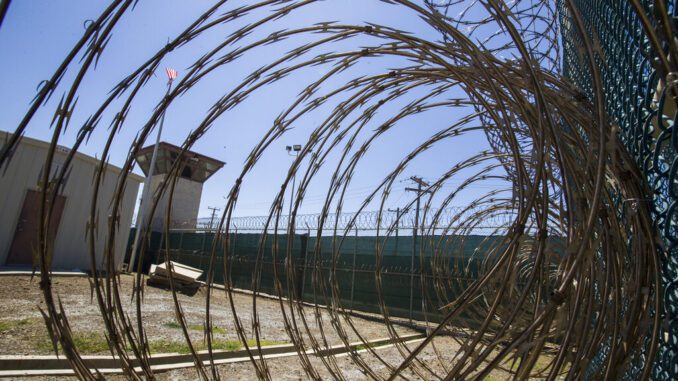
WASHINGTON, D.C. — The Biden administration took a step toward its goal of shutting down the Guantánamo Bay detention center for international terror suspects on Monday, releasing into the custody of his home country a Moroccan who’d been held without charge almost since the U.S. opened the facility 19 years ago.
The transfer of Abdullatif Nasser was the first by the Biden administration, reviving an Obama administration effort that had been stymied, in part, by conservative opposition and by the difficulty of finding secure sites to send some of the detainees.
A review board had recommended repatriation for Nasser, who is in his mid-50s, in July 2016, but he had remained at Guantánamo under President Donald Trump, who opposed closing the site.
In announcing Nasser’s transfer, the Pentagon cited the board’s determination that his detention was no longer necessary to protect U.S. national security.
Nasser, also known as Abdul Latif Nasser, arrived Monday in Morocco. Police took him into custody and said they would investigate him on suspicion of committing terrorist acts.
Nasser’s attorney in Morocco, Khalil Idrissi, said the years Nasser spent in Guantánamo “were unjustified and outside the law, and what he suffered remains a stain of disgrace on the forehead of the American system.”
The State Department said in a statement that President Joe Biden’s administration would continue “a deliberate and thorough process” aimed at reducing the detainee population at Guantánamo.
White House press secretary Jen Psaki had said in February it was the “intention” of the Biden administration to close the detention facility, something President Barack Obama pledged to do within a year shortly after he took office in January 2009.
Almost 800 detainees have passed through Guantanamo. Of the 39 remaining, 10 are eligible to be transferred out, 17 are eligible to go through the review process for possible transfer, another 10 are involved in the military commission process used to prosecute detainees and two have been convicted, another senior administration official said.
The Biden administration didn’t address how it would handle the ongoing effort to prosecute five men held at Guantánamo for the Sept. 11 attacks. It also has to resolve what it will do with detainees that the Obama administration particularly struggled with, either because their home countries were not considered secure enough to return them to, or because they were refused by third-party countries.
The detention center opened in 2002. Bush’s administration transformed what had been a quiet Navy outpost on Cuba’s southeastern tip into a place to interrogate and imprison people suspected of links to al-Qaida and the Taliban.
The Obama administration, seeking to allay concerns that some of those released had “returned to the fight,” set up a process to ensure those repatriated or resettled in third countries no longer posed a threat. It also planned to try some of the men in federal court.
But the closure effort was thwarted when Congress barred the transfer of prisoners from Guantánamo to the U.S., including for prosecution or medical care.
The prisoner transfer process stalled under Trump, who said even before taking office there should be no further releases. “These are extremely dangerous people and should not be allowed back onto the battlefield,” Trump said.
Under Trump, only one prisoner, a Saudi, was transferred to Saudi Arabia to serve the remainder of his sentence after he agreed to a plea bargain.
Under Obama, 197 were transferred to other countries.
The possibility that former Guantánamo prisoners would resume hostile activities has long been a concern that has played into the debate over releases. The office of the Director of National Intelligence said in a 2016 report that about 17% of the 728 detainees who had been released were “confirmed” and 12% were “suspected” of reengaging in such activities.
But the vast majority of those reengagements occurred with former prisoners who did not go through the security review that was set up under Obama. A task force that included agencies such as the Defense Department and the CIA analyzed who was held at Guantánamo and determined who could be released and who should continue in detention.
The U.S. thanked Morocco for facilitating Nasser’s transfer.
“The United States commends the Kingdom of Morocco for its long-time partnership in securing both countries’ national security interests,” the Pentagon statement said.
In a statement, the public prosecutor at the Court of Appeal in Rabat said the National Division of the Judicial Police in Casablanca had been instructed to open an investigation into Nasser “on suspicion of committing terrorist acts.”
Idrissi, Nasser’s attorney, said judicial authorities should not “take measures that prolong his torment and suffering, especially since he lived through the hell of Guantánamo.”
Nasser’s journey to the Cuban prison was a long one. He was a member of a nonviolent but illegal Moroccan Sufi Islam group in the 1980s, according to his Pentagon file. In 1996, he was recruited to fight in Chechnya but ended up in Afghanistan, where he trained at an al-Qaida camp. He was captured after fighting U.S. forces there and was sent to Guantánamo in May 2002.



